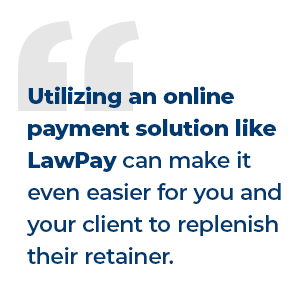The client intake process is arguably the most critical part of your law firm management. It’s how you get clients, procure retainers, and generate cash flow. The initial client consultation sets the tone for the entire case, so make sure you start off on the right foot every time by adhering to these five simple steps.
1. Collect the Consultation Fee Prior to the Initial Meeting Taking Place
If you charge a fee, make it very clear, in writing, that payment of said fee is due prior to the consultation. The simplest way to accomplish this is to email a link to the client that enables them to pay online. (An online payment solution like LawPay makes this easy.)
2. Give the Client a Roadmap of the Process and Realistic Expectations
Too often, attorneys make promises at initial meetings because the matter seems so simple at first. Be careful about using absolutes and making any promises at the outset of the case—no matter how sure you might be. Also, be clear about the costs of the case, and make sure your client understands when and how they’ll be expected to pay. You can make this easier on them and improve your chances of getting paid by utilizing an online payment solution that will allow your clients to pay at their convenience and on time.

3. Have the Fee Agreement Already Filled Out
The only thing you should need to do is plug in the retainer amount and print it out or email it to the client at the conclusion of your meeting. Having it ready to go at the meeting eliminates friction and prevents awkward pauses during the consultation.
4. Have the Client Initial by the Evergreen Clause
Many attorneys utilize retainers, as opposed to flat fees, for their payment. When the retainer dips below a certain amount, the client will be sent an evergreen letter, which asks the client to replenish their retainer up to the original amount. If you utilize this practice (and you should), make sure to explain this in detail to the client and have them initial by a clause explaining the same in their fee agreement. Utilizing an online payment solution can make it even easier for you and your client to replenish their retainer.
5. Seal the Deal
Make it very clear to the client that you do not begin working, and you are not retained as their attorney, until you receive the following: their fully executed fee agreement and their retainer payment.
Signing clients is no small feat, and your firm’s intake policy should be tailored to make the process as painless as possible for the firm and the potential client. By utilizing the above steps, you should be able to eliminate future headaches and pitfalls. You can also avoid payment-related stressors by giving potential and existing clients the option to pay by credit card. With LawPay (the only payment solution offered through the ABA Advantage program), you can easily and securely accept credit card and eCheck payments.
I hope these tips are helpful to your practice! Feel free to drop me a line at jturk@lawpay.com and let me know your thoughts.
About the Author:
Jordan Turk is a practicing attorney in Texas and the Legal Content & Compliance Manager at LawPay. She has a B.A. from the University of Texas and earned her law degree from the University of Arkansas School of Law.
###

